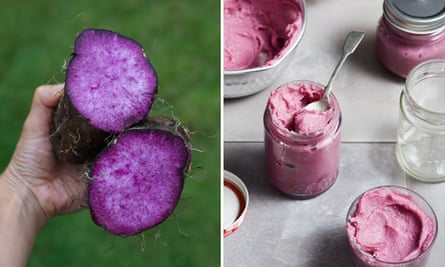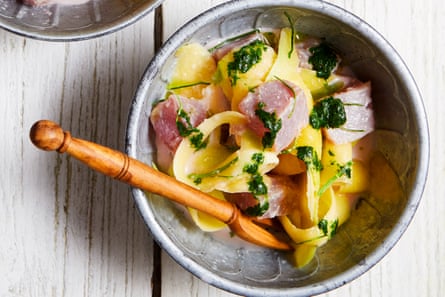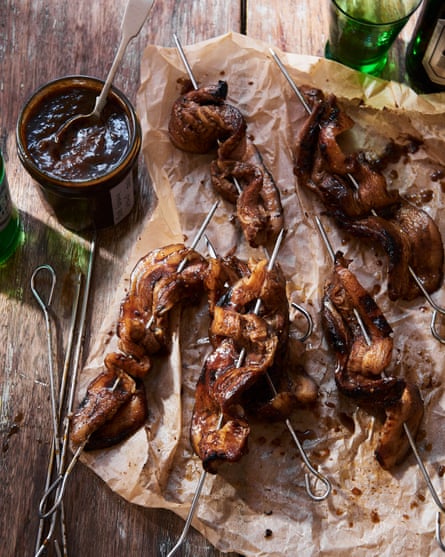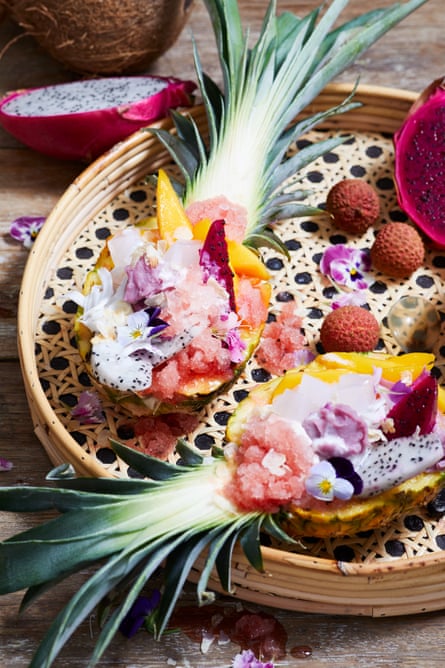
For cookbook author Yasmin Newman, food was a gateway to appreciating her culture. Born in Australia to a Filipina mum and an Anglo dad, she grew up eating dishes her mother prepared, such as longsilog (Filipino sausage and fried rice) for breakfast, nilaga (beef soup) for dinner and biko (coconut caramel sticky rice) for snacks in between.
“[With] each bite, I’d absorb the Philippines’ distinctive culture,” Newman says. “Delicious and disarming, yet layered with history and meaning.”
Visits to the Philippines to see family gave her a “strong sense of identity” and pride in her heritage, which she did not see represented in Australian food culture.
“Filipinos are the fifth-largest migrant group in Australia but, as a child and young adult, there were only a handful of Filipino restaurants and very little documented on the cuisine in Australia,” she says.
For 7000 Islands, her 2013 cookbook on Filipino food, Newman travelled the Philippines from “top to tail”, meeting home cooks and local food champions. “At the same time, it highlights how young chefs are cooking in the Philippines, as well as first and second generation migrants in the diaspora just like me, as we proudly shape, share and champion our cuisine,” she says.
A typical Filipino spread
“In the Philippines, food is all about customisation,” Newman says. “You will never find one dish per person as [per] western restaurants or a centrepiece [like a roast]. Instead, tabletops are laden with options. Guests start with an empty plate and choose their own culinary adventure.”
This interactive eating style, she says, commonly features sawsawan (dipping sauces).
“In Filipino, the word sawsawan derives from the verb ‘to dip’,” Newman says. “Watch and you’ll see Filipinos dunking everything from breakfast items through to midnight snacks. Think crispy pork kawali doused in a tart mix of native vinegar and garlic, or crunchy green mangoes used to scoop up sticky bagoong (shrimp paste). Sawsawan can be traced back to the tribal communities of the Philippines’ history, where communal dining was the norm.
“Today, the tradition continues and food is a partnership between cook and eater. An experienced cook expects guests to fine-tune each dish with sawsawan.”
How to eat
There are “no rules” when eating in the Philippines, with diners loading their plates with an assortment of savoury and sweet dishes for “riotous flavour”. She is particularly drawn to the food of Siargao, an island in the south-east of the archipelago.
“Here, the food is light, fresh, tart and seafood- and vegetable-laden,” she says. “One of my favourite [dishes] is kinilaw, similar to ceviche. Just-caught fish is cut into bite-size morsels, tossed with vinegar, kalamansi and fresh coconut milk, and served with a medley of herbs, vegetable and rice.”

And no island resort will skip adobo, the country’s unofficial national dish: “an addictive braise of pork and chicken in soy sauce and native vinegar”.
She says a kamayan spread is one way to bring an “instant summer vibe” to a meal.
“Lay the table with banana leaves to cover, then mound an array of Filipino favourites in the middle for guests to eat with their hands,” she says. “There are few things more enjoyable than an afternoon like this.”
The country’s staple ingredients, she says, include garlic, onion, tomato, soy sauce, kalamansi, bagoong, muscovado and native vinegars (such as cane, nipa palm and coconut), which contribute to the cuisine’s sour, salty, sweet and bitter flavours.
Native fruits such as green mango, buko (young coconut), atsuete (annatto) and ube (purple yam) are also prominent. While they are available in Australian supermarkets in frozen forms, she says it’s worth visiting specialty grocers for the fresh stuff – especially kalamansi – is “worth the hunt for the sublime taste”.
Grilled seafood is also in abundance, in dishes like inihaw na pusit (squid stuffed with a tomato and onion) or pinaputok (fish in banana leaf); as is smoky barbecued meat.

A sweet finish
It is common for beachside stalls to peddle sweet snacks such as maruya (banana fritter) and kamote cue (caramelised sweet potato skewers).
But one of Newman’s favourite desserts is halo halo: “a mountain of shaved ice drenched in creamy evaporated milk with a kaleidoscope of mix-ins, from leche flan to candied beans”.
“It’s consumed almost daily as a reprieve from the tropical heat and the variations are as endless as your imagination,” she says. “This version, with watermelon granita and coconut milk in place of shaved ice and condensed milk, is inspired by my island life on Siargao and [is] a celebration of our tropical fruit.”
Watermelon ice with mango, coconut jelly and ube jam, inspired by halo halo – recipe

“Halo halo is, arguably, the most-loved dessert of the Philippines. Descended from Japanese kakigori, this mountain of shaved ice drenched in creamy evaporated milk, offers a hallowed moment of pleasure and reprieve from the oppressive heat. Made with a kaleidoscope of sweet and savoury mix-ins from leche flan to candied beans, halo halo (meaning mix mix, signalling the action of bringing it all together), is as endless as your imagination.
“This beautiful version with watermelon granita and coconut milk in place of shaved ice and evaporated and condensed milks is inspired by island life on Siargao, where colourful tropical fruit is always in reach. For me, it’s even more special served in pineapple bowls as I have done here, or baby watermelon, dragon fruit shells or young coconut husks, but it looks and tastes just as good in a traditional sundae glass or bowl.”
Makes 4
2 baby or small pineapples (optional)
1 mango, thinly sliced or scooped into balls using a melon baller
1 star apple, dragon fruit or star fruit, cut into wedges
A handful of lychees, peeled and pitted
260g nata de coco or kaong (1 cup, preserved sugar palm fruit), drained
100g store-bought ube jam (⅓ cup)
1 young coconut, flesh scraped into thin ribbons using a vegetable peeler
A handful of butterfly pea flowers or other edible flowers
15g pinipig (⅓ cup, pounded rice flakes), toasted
625ml coconut milk (2½ cups)
For the watermelon granita
¼ seedless watermelon (about 1kg), rind removed
220g caster sugar (1 cup)
To make the watermelon granita, place the watermelon in a blender and blend until smooth. Strain, discard the solids, and measure out 1.25 litres of juice. Place the sugar and half the watermelon juice in a saucepan over low heat and stir until the sugar is dissolved. Transfer the mixture and the remaining watermelon juice to a large container and freeze for one hour or until frozen. Using a fork, scrape the watermelon granita into ice crystals. Freeze until needed.
Meanwhile, if you’d like to make pineapple bowls, cut the pineapples in half lengthways, then cut out the flesh, keeping the skin intact. Reserve the flesh for another use.
To serve, divide the watermelon granita among the pineapple bowls, then top with the mango, star apple, dragon fruit or star fruit, lychees, nata de coco or kaong, yam jam, coconut, flowers and pinipig. Drizzle over the coconut milk and serve immediately.
-
The recipe is an edited extract from Under Coconut Skies by Yasmin Newman, available now through Smith Street Books (RRP $55).



